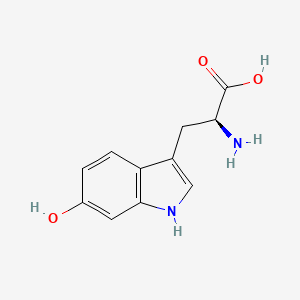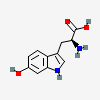6-Hydroxy-L-tryptophan
- 13567-14-1
- 6-HYDROXY-L-TRYPTOPHAN
- (S)-2-Amino-3-(6-hydroxy-1H-indol-3-yl)propanoic acid
- 6-hydroxytryptophan
- (S)-2-Amino-3-(6-hydroxy-1H-indol-3-yl)propanoicacid
- Create:2011-02-17
- Modify:2025-01-04


- 13567-14-1
- 6-HYDROXY-L-TRYPTOPHAN
- (S)-2-Amino-3-(6-hydroxy-1H-indol-3-yl)propanoic acid
- 6-hydroxytryptophan
- (S)-2-Amino-3-(6-hydroxy-1H-indol-3-yl)propanoicacid
- (2S)-2-amino-3-(6-hydroxy-1H-indol-3-yl)propanoic acid
- Tryptophan, 6-hydroxy-
- SCHEMBL179963
- DTXSID60678820
- MFCD19105439
- CS-W000483
- DB-328086
- 6-Hydroxy-L-tryptophan (H-L-Trp(6-OH)-OH)
- Q27466719

H302 (100%): Harmful if swallowed [Warning Acute toxicity, oral]
H315 (100%): Causes skin irritation [Warning Skin corrosion/irritation]
H319 (100%): Causes serious eye irritation [Warning Serious eye damage/eye irritation]
P264, P264+P265, P270, P280, P301+P317, P302+P352, P305+P351+P338, P321, P330, P332+P317, P337+P317, P362+P364, and P501
(The corresponding statement to each P-code can be found at the GHS Classification page.)
Acute Tox. 4 (100%)
Skin Irrit. 2 (100%)
Eye Irrit. 2 (100%)
Patents are available for this chemical structure:
https://patentscope.wipo.int/search/en/result.jsf?inchikey=NXANGIZFHQQBCC-VIFPVBQESA-N
- EPA DSSTox6-Hydroxy-L-tryptophanhttps://comptox.epa.gov/dashboard/DTXSID60678820CompTox Chemicals Dashboard Chemical Listshttps://comptox.epa.gov/dashboard/chemical-lists/
- European Chemicals Agency (ECHA)LICENSEUse of the information, documents and data from the ECHA website is subject to the terms and conditions of this Legal Notice, and subject to other binding limitations provided for under applicable law, the information, documents and data made available on the ECHA website may be reproduced, distributed and/or used, totally or in part, for non-commercial purposes provided that ECHA is acknowledged as the source: "Source: European Chemicals Agency, http://echa.europa.eu/". Such acknowledgement must be included in each copy of the material. ECHA permits and encourages organisations and individuals to create links to the ECHA website under the following cumulative conditions: Links can only be made to webpages that provide a link to the Legal Notice page.https://echa.europa.eu/web/guest/legal-notice6-HYDROXY-L-TRYPTOPHANhttps://echa.europa.eu/substance-information/-/substanceinfo/100.286.8526-HYDROXY-L-TRYPTOPHAN (EC: 849-474-8)https://echa.europa.eu/information-on-chemicals/cl-inventory-database/-/discli/details/295377
- Japan Chemical Substance Dictionary (Nikkaji)
- LOTUS - the natural products occurrence databaseLICENSEThe code for LOTUS is released under the GNU General Public License v3.0.https://lotus.nprod.net/(S)-2-Amino-3-(6-hydroxy-1H-indol-3-yl)propanoic acidhttps://www.wikidata.org/wiki/Q27466719LOTUS Treehttps://lotus.naturalproducts.net/
- Protein Data Bank in Europe (PDBe)
- Springer Nature
- Wikidata6-hydroxytryptophanhttps://www.wikidata.org/wiki/Q27466719
- PubChem
- GHS Classification (UNECE)GHS Classification Treehttp://www.unece.org/trans/danger/publi/ghs/ghs_welcome_e.html
- MolGenieMolGenie Organic Chemistry Ontologyhttps://github.com/MolGenie/ontology/
- PATENTSCOPE (WIPO)SID 389067914https://pubchem.ncbi.nlm.nih.gov/substance/389067914

